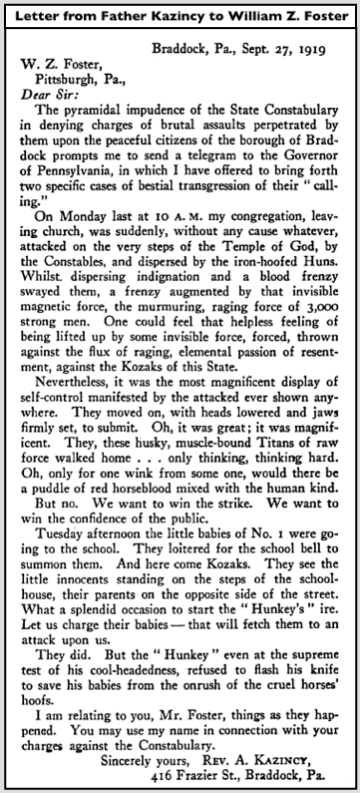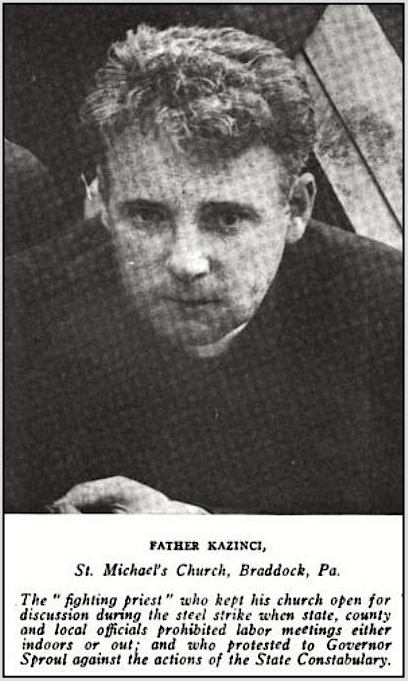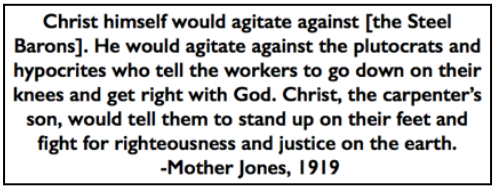 ———-
———-
Hellraisers Journal – Tuesday January 6, 1920
Braddock, Pennsylvania – Father Kazincy Stands with Strikers
From the Topeka Kansas Trades Unionist of January 2, 1920:
STEEL OWNERS FEAR POWER
-PASTOR ST. MICHAEL’S CHURCH[by Edwin Newdick.]
The steel strike has revealed no more glorious devotion to the cause of workingmen than that of Reverend Father Adalbert Kazinci [Kazincy], pastor of St. Michael’s Roman Catholic Church at Braddock, Pa., where one of the huge mills of the Carnegie Steel Company is situated and near which are also the big mills of Homestead and Rankin. Today there probably are many more than 10,000 men on strike who would have been cajoled, discouraged or frightened back into the mills but for the clear, fearless stand of Father Kazinci in the teeth of everything which the steel companies could devise to calumniate him, destroy his influence and wipe out his parish.
The end is not yet. The despots of steel never forgive and never forget. Father Kazinci at this moment is calmly facing the possibility that the steel-companies will, whatever the outcome of the strike, employ discrimination and discharge to disperse his congregation. He is too clear visioned not to have realized this possibility from the first; but he is too courageous to waver from any consideration of expediency or personal comfort.
Only a part of the story of blackmail, intimidation and every device or conscienceless desperation employed by the steel magnates against him and his parishioners can be told in the space available. Every friend of labor who reads it should engrave indelibly in his memory the name of an apostle of applied Christianity, a hero-in labors struggle for freedom, Father Kazinci.
His church and parish house are perched on a precipitous hillside on a little bye street of Braddock down which the children from the parochial school slide, tumble and roll in the glee he loves to see and hear. If you pass through the iron gate, and up the walk to the door of his home, you will, it is likely, encounter a broad faced, kind eyed Slav tiding up the little front yard. This man will almost leap in the eagerness of his solicitude to serve you-for are you not visiting Father Kazinci? Then must you, indeed, be a person of great worth. In the deep eyes of this humble attendant you will read more of the place Father Kazinci holds in the hearts of his parishioners than a masters pen could-write.
No clergyman in the steel towns whose stand was the least in question was permitted any doubts as to what was expected of him in the strike. A couple of days before the strike, the officers of the Carnegie Steel Company gave a dinner to clergymen at the Carnegie Steel Club-where employees of the office class are accustomed to foregather. In fact, the Carnegie officers gave two dinners, one for Catholic clergymen and one for Protestant clergymen. The officers of steel companies, evidently, do not let denominational lines hamper the establishment of satisfactory relations between’ religion and business.
At these dinners, officers of the Carnegie Steel Company explained the the great importance of the steel mills to the prosperity of Braddock. It was pointed out that, in fact, there wouldn’t be anything to Braddock but for the steel mills in which case no church could possibly prosper, anyone will admit. That point was touched on in various ways. It was mentioned several times. It was made very clear. It might not be exaggeration to say that the point was,emphasized. The folly of a strike by steel workers could be easily pointed out, after that point was established
There were a number of clergymen at each of these dinners. One sincere (though, perhaps, naive) clergyman rose and said that he had been given to understand that the meeting was to discuss collective bargaining for the steel industry but he found that he had been summoned merely to enlist his service in strike breaking. He thereupon walked out.
It was not Father Kazinci who spoke thus and thus retired. No Father Kazinci was not present.
[He explains:]
I was graduated some time ago from the kindergarten course in the relations of big business with the church. I knew what they wanted. I did not need to go. But, I assure you, I had several personal and special invitations.
Then he laughs, for these special invitations are easily explained. Well in advance of the day upon which the strike was set, September 22, Father Kazinci had told his parishioners flatly and emphatically to come out every man of them. The Carnegie Company officers were, naturally particularly desirous of dining with Father Kazinci.
The strike came. The way the parishioners of St. Michael’s responded in no wise lessened the interest of the Carnegie Steel Company in the Reverend Adelbert Kazinci.
A group of charitable societies were making a drive about this time for a large sum for the support of Allegheny county institutions. Some feelers were put out by a diplomatic gentleman in the Steel Company offices in Pittsburg as to the possibilities of utilizing this situation to convince Father Kazinci of the altruism of the owners of the Braddock mills. They found they were in a blind alley. Father Kazinci had made a condition of his participation that no contributions be accepted from the steel corporations.
Thereupon the Carnegie Company apparently decided to quit fooling and act in earnest. A councilman of Braddock, a parishioner of St. Michael’s, was told that complete information as to his pastor’s excursions in “red light” houses was available, also a “document” establishing very serious charges against the priest and that publication of this “document” was inevitable unless the priest adopted a different attitude. Just what “charges” the document would establish wasn’t specified-evidently it was assumed that a guilty conscience would put fear in the pastor’s heart and accomplish the desired result. But when your own house is clean people have to look elsewhere for mud to throw at you. Father Kazinci went calmly ahead telling his parishioners at every service the meaning and importance of the strike and how to win it.
Another move in this campaign was a letter purporting to have been written by a good Catholic working in the mill and stating that the writer couldn’t stand the terrible things which were being spread about by Father Kazinci and asking an appointment when he could tell him about it. Father Kazinci ignored the letter. Then the local Italian priest came to Father Kazinci telling him that stories were being spread that Father Kazinci was inciting his parishioners to kill Italians and that, in fact, an Italian had been murdered by one of Father Kazinci’s flock. However, this move also failed. No Italian was worked up a rage which led him to an attempt on Father Kazinci’s life.
A plan was under way before the strike to dispose of the property now occupied by St. Michael’s and build a new church, school and parish house in North Braddock. The land had been acquired and was held under a mortgage. Father Kazinci had been refraining from asking any of his flock for money to raise this mortgage while their slender resources were strained by their strike. Along came a demand from the agents of the property that he immediately produce the interest on the mortgage or settle it in full. Father Kazinci told his people about it. They raised $1,100, $300 more than necessary.
And the terrorism of the State Constabulary-riding into the congregation and up the church steps, riding into first grade children, riding into a strikers funeral procession, etc. The result? Thousands of strikers knowing what labor solidarity means; a fraction of normal production in the mills, one quiet, earnest priest with a place in thousands of hearts not to be exchanged for any shrine built by hands.
[Letter added; emphasis added.]
~~~~~~~~~~~~~~~~~~~~~~
SOURCES & IMAGES
Quote Mother Jones, Fight for Righteousness n Justice, Gary IN Oct 23, 1919, Ab Chp 24
https://www.iww.org/history/library/MotherJones/autobiography/24
Kansas Trades Unionist
(Topeka, Kansas)
-Jan 2, 1920
https://www.newspapers.com/image/519799876/
For Edwin Newdick as author of article, see,
–Quarry Workers Journal of Jan 1, 1920:
https://www.newspapers.com/image/405050414/
The Great Steel Strike and Its Lessons
-by William Z. Foster
B. W. Huebsch, Incorporated, 1920
https://books.google.com/books?id=Hbt-AAAAMAAJ
–Edwin Newdick, head of publicity for National Committee
https://play.google.com/books/reader?id=Hbt-AAAAMAAJ&printsec=frontcover&pg=GBS.PA185
–Rev Kazincy:
https://play.google.com/books/reader?id=Hbt-AAAAMAAJ&printsec=frontcover&pg=GBS.PA117
Braddock-There the heroic Slavish priest, Reverend Adelbert Kazincy, pastor of St. Michel’s Roman Catholic church, bade defiance to the Steel Trust and all its minions.
–Letter from Father Kazincy to WZF Sept 1919, GSS p121, 1920
https://play.google.com/books/reader?id=Hbt-AAAAMAAJ&printsec=frontcover&pg=GBS.PA121
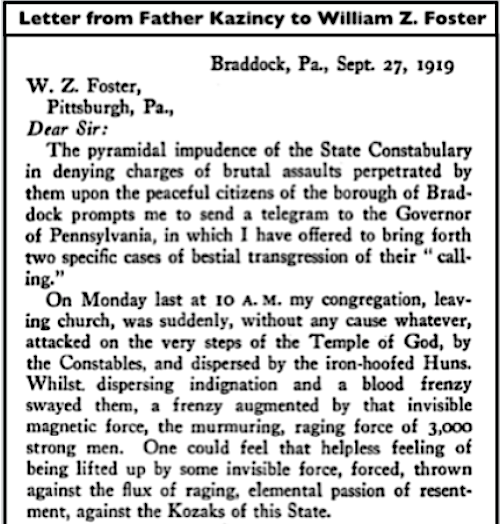
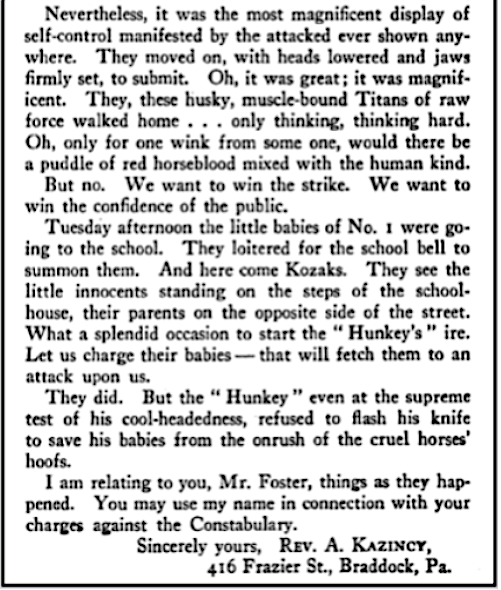
See also:
Tag: Great Steel Strike of 1919
https://weneverforget.org/tag/great-steel-strike-of-1919/
Tag: Father Adalbert Kazincy
https://weneverforget.org/tag/father-adalbert-kazincy/
Adalbert Kazincy, FindaGrave
https://www.findagrave.com/memorial/78258982/adalbert-kazincy
Note: I have settled on “Kazincy” as correct name of “Father K”- I have found more spellings used than I count, making it difficult to follow Father K in newspapers. Other common spellings: Kazinczy, Kazinci, Kazinsky.
Adalbert Kazinczy, 1894 ordained as priest:
https://play.google.com/books/reader?id=YjNJAQAAMAAJ&hl=en&pg=GBS.RA2-PA28
Adalbert Kazinci, Survey p537, Feb 7, 1920
https://play.google.com/books/reader?id=MoEbAQAAMAAJ&printsec=frontcover&pg=GBS.PA537
Men and Steel
-by Mary Heaton Vorse
NY, 1920
(search: kazinci)
https://archive.org/details/mensteel00vors/page/n5
Striking Gridiron
A Town’s Pride and a Team’s Shot at Glory During
the Biggest Strike in American History
-by Greg Nichols
Macmillan, Sep 16, 2014
(search: kazinsky)
https://books.google.com/books?id=FcUWBAAAQBAJ
In Braddock, a priest named Adalbert Kazinsky stood defiantly atop the steps of St. Michel’s church and refused entry to police.
“Father K”
https://www.broadwayworld.com/pittsburgh/regional/Father-K-317806
~~~~~~~~~~~~~~~~~~~~~~~~~~~~~~~~~~~~~~~~~~~~~
Which Side Are You On? – Natalie Merchant

